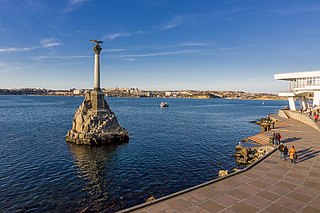
Sevastopol, sometimes written Sebastopol, is the largest city in Crimea and a major port on the Black Sea. Due to its strategic location and the navigability of the city's harbours, Sevastopol has been an important port and naval base throughout its history. Since the city's founding in 1783 it has been a major base for Russia's Black Sea Fleet. During the Cold War of the 20th century, it was a closed city. The total administrative area is 864 square kilometres (334 sq mi) and includes a significant amount of rural land. The urban population, largely concentrated around Sevastopol Bay, is 479,394, and the total population is 547,820.

Russia is divided into several types and levels of subdivisions.
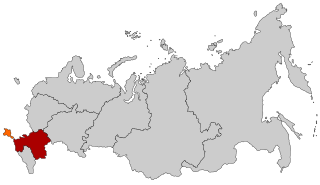
The Southern Federal District is one of the eight federal districts of Russia. Its territory lies mostly on the Pontic–Caspian steppe of Southern Russia. The Southern Federal District shares borders with Ukraine, the Azov Sea, and the Black Sea in the west, and Kazakhstan and the Caspian Sea in the east.
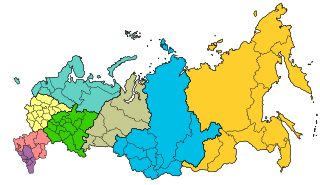
The federal districts are groupings of the federal subjects of Russia. Federal districts are not mentioned in the nation's constitution, and do not have competences of their own and do not manage regional affairs. They exist solely to monitor consistency between the federal and regional bodies of law, and ensuring governmental control over the civil service, judiciary, and federal agencies, operating in the regions.

The federal subjects of Russia, also referred to as the subjects of the Russian Federation or simply as the subjects of the federation, are the constituent entities of Russia, its top-level political divisions according to the Constitution of Russia. Kaliningrad Oblast is the only federal subject geographically separated from the rest of the Russian Federation by other countries.
The politics of Crimea today is that of the Republic of Crimea on one hand, and that of the federal city of Sevastopol on the other, within the context of the largely unrecognised annexation of Crimea by the Russian Federation in March 2014.
Yuri Aleksandrovich Meshkov was a Ukrainian politician and leader of the pro-Russian movement in Crimea. He served as the only President of Crimea from 1994 to 1995.

The Constitution of the Autonomous Republic of Crimea is the basic law of the Autonomous Republic of Crimea, a republic on the Crimean peninsula as part of Ukraine. The constitution establishes the republic's status and authority within Ukraine. It granted Crimea the right to draft a budget and manage its own property.

The Council of Ministers of the Autonomous Republic of Crimea, briefly SovMin, is the executive branch of government of the Autonomous Republic of Crimea, a republic within southern Ukraine that is currently suspended due to Russian occupation of the Crimean Peninsula since February 27, 2014. The Council of Ministers derived its authority from the Constitution and laws of Ukraine and normative acts of the Verkhovna Rada of Crimea which bring them into its competency.
The Crimean status referendum of 2014 was a disputed referendum on March 16, 2014, concerning the status of Crimea that was conducted in the Autonomous Republic of Crimea and the city of Sevastopol after Russian forces seized control of Crimea.

The Autonomous Republic of Crimea is an administrative division of Ukraine encompassing most of Crimea that was unilaterally annexed by Russia in 2014. The Autonomous Republic of Crimea occupies most of the peninsula, while the City of Sevastopol occupies the rest.

In February and March 2014, Russia invaded the Crimean Peninsula, part of Ukraine, and then annexed it. This took place in the relative power vacuum immediately following the Revolution of Dignity. It marked the beginning of the Russo-Ukrainian War.

The Republic of Crimea is a republic of Russia, comprising most of the Crimean Peninsula, but excluding Sevastopol. Its territory corresponds to the pre-2023 territory of the Autonomous Republic of Crimea, a de jure subdivision of Ukraine. Russia occupied and annexed the peninsula in 2014, although the annexation remains internationally unrecognized.

Natalia Vladimirovna Poklonskaya is a Ukrainian-born Russian lawyer, politician and diplomat. She has served as the adviser to the Prosecutor General of Russia since 14 June 2022. Previously, she had several political and diplomatic roles, most notably serving as the Prosecutor General of Crimea from 2014 to 2016, and later served as a Deputy of the State Duma of Russia from 2016 to 2021, as well as the Deputy Head of Rossotrudnichestvo from February to June 2022.
The Ministry of Crimean Affairs was a federal ministry in Dmitry Medvedev's government which was established on March 31, 2014; and dissolved on July 15, 2015.
The Crimean problem or the Crimean question is a dispute over the status of Crimea between Ukraine and Russia.
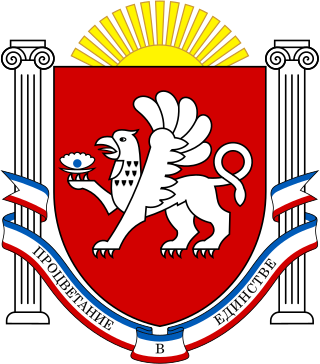
The Head of the Republic of Crimea is the highest official and the head of the executive power of the Republic of Crimea; an internationally disputed federal subject of the Russian Federation located on the Crimean Peninsula.

The coat of arms of Sevastopol is a heraldic symbol representing the city of Sevastopol, Crimea. It is featured in the middle of the flag of Sevastopol on a red background.

Vladimir Mikhailovich Dzhabarov, is an Uzbek-born Russian statesman, politician, and former government agent who is a member of the Federation Council of from the Legislative Assembly of the Jewish Autonomous Oblast since 24 September 2009. He is a member of the United Russia party.
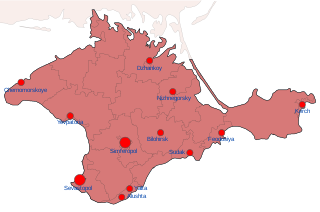
On 27 February 2014, unmarked Russian soldiers were deployed to the Crimean Peninsula in order to wrest control of it from Ukraine, triggering the Russo-Ukrainian War. This military occupation, which the Ukrainian government considers to have begun on 20 February, laid the foundation for the Russian annexation of Crimea on 18 March 2014. Under Russia, the Ukrainian Autonomous Republic of Crimea was replaced by the Republic of Crimea, though the legitimacy of the latter is scarcely recognized internationally.















